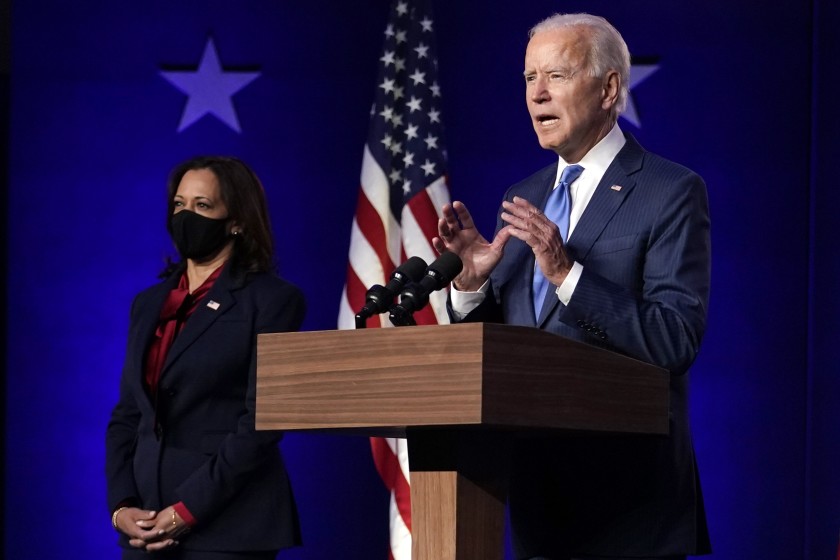The Trump Card
History In The Making As Biden Wins Presidency
Via Carolyn Kaster with the Associated Press.
Former Vice President Joe Biden speaks Friday in Wilmington, Del., as his running mate, California Sen. Kamala Harris, listens.
November 13, 2020
As Election Day turned into “Election Week”, American families were anxiously awaiting the final results that drew the big question: Who will be the next President of the United States?
BREAKDOWN OF THE ELECTION
Election night on November 3, ended without a clear winner, as many state results were too close to call and millions of votes remained uncounted, including in the key battleground states of Wisconsin, Michigan, Pennsylvania, North Carolina, Georgia, Arizona, and Nevada. Results were delayed in these states due to local rules on counting mail-in ballots. In a victory declared after midnight, Trump won the swing state of Florida by three percentage points, an increase from his 1.2 percentage point margin in 2016, has seen significant gains in support among the Latino community in Miami-Dade County. Shortly after 12:30 a.m., Biden made a short speech in which he urged his supporters to be patient while the votes are counted, and said he believed he was “on track to win this election”. Shortly before 2:30 a.m., Trump made a speech to a roomful of supporters, falsely asserting that he had won the election and calling for a stop to all vote counting, saying that continued counting was “a fraud on the American people” and that “we will be going to the U.S. Supreme Court.” The Biden campaign denounced these attempts, claiming that the Trump campaign was engaging in a “naked effort to take away the democratic rights of American citizens”.
Throughout the week following the election, President Trump repeatedly claimed that he won the election. In Pennsylvania, where the counting of mail-in ballots began on election night, Trump declared victory on November 4 with a lead of 675,000 votes, despite more than a million ballots remaining uncounted. Trump also declared victory in North Carolina and Georgia, despite many ballots still being uncounted. Fox News and CNN both projected Biden would win Arizona at 11:20 p.m. on election night, and the Associated Press called the state at 2:50 a.m. on November 4; however, several other media outlets concluded the state was too close to call. By the evening of November 4, the Associated Press reported that Biden had secured 264 electoral votes by winning Michigan and Wisconsin, with Pennsylvania, North Carolina, Georgia, and Nevada remaining uncalled. Biden had a 1% lead in Nevada and a 2.3% lead in Arizona by November 5, needing only to win Nevada and Arizona or win Pennsylvania to obtain the necessary 270 electoral votes.
On November 5, a federal judge dismissed a lawsuit by the Trump campaign to stop vote-counting in Pennsylvania. The Trump campaign had alleged that its observers were not given access to observe the vote, but its lawyers admitted during the hearing that its observers were already present in the vote-counting room. Also that day, a state judge dismissed another lawsuit by the Trump campaign that alleged that in Georgia, late-arriving ballots were counted. The judge ruled no evidence had been produced that the ballots were late. Meanwhile, a state judge in Michigan dismissed the Trump campaign’s lawsuit requesting a pause in vote-counting to allow access to observers, as the judge noted that vote-counting had already finished in Michigan. That judge also noted the official complaint did not state “why”, “when, where, or by whom” an election observer was allegedly blocked from observing ballot-counting in Michigan.
On November 6, Biden assumed leads in Pennsylvania and Georgia as the states continued to count ballots, and absentee votes in those states heavily favored Biden. Due to the slim margin between Biden and Trump in the state, Georgia Secretary of State Brad Raffensperger announced on November 6 that a recount would be held in Georgia. At that point, Georgia had not seen “any widespread irregularities” in this election, according to the voting system manager of the state, Gabriel Sterling. Also, U.S. Supreme Court Justice Samuel Alito issued an order requiring officials in Pennsylvania to segregate late-arriving ballots, amid a dispute as to whether the state’s Supreme Court validly ordered a 3-day extension of the deadline for mail-in ballots to arrive. Several Republican attorneys general filed amicus briefs before the U.S. Supreme Court in subsequent days agreeing with the Pennsylvania GOP’s view that only the state legislature could change the voting deadline.
THE ELECTION CALL
On November 6, election-calling organization Decision Desk HQ projected that Biden had won the election after forecasting that Biden had won Pennsylvania. According to Decision Desk HQ’s accounting, Pennsylvania’s 20 electoral votes gave Biden a total of 273 electoral votes, three over the threshold to make him president-elect. Decision Desk HQ’s partner organizations, Vox and Business Insider, also called the race at that time. Decision Desk HQ president Drew McCoy told Vox that the great majority of mail-in ballots from Pennsylvania were mostly from heavily Democratic areas around Philadelphia and Pittsburgh. According to McCoy, Biden was winning the mail-in vote in those areas so overwhelmingly that Trump had no realistic path to hold the state.
By November 7, several prominent Republicans had publicly denounced Trump’s claims of electoral fraud, saying they were unsubstantiated, baseless or without evidence, damaging to the election process, undermining democracy, and dangerous to political stability while others supported his demand of transparency. According to CNN, people close to Donald Trump, such as his son-in-law and senior adviser Jared Kushner and his wife Melania Trump, urged him to accept his defeat. While Donald Trump privately acknowledged the outcome of the presidential election, he nonetheless encouraged his legal team to continue pursuing legal challenges.
On that same morning, ABC News, NBC News, CBS News, the Associated Press, CNN, and Fox News all called the election for Biden, based on projections of votes in Pennsylvania showing him leading outside of the recount threshold (0.5%).
AFTERMATH
Protests against Trump’s challenges to the election results took place in Minneapolis, Portland, New York, and other cities. Police in Minneapolis arrested more than 600 demonstrators for blocking traffic on an interstate highway. In Portland, the National Guard was called out after some protesters smashed windows and threw objects at police. At the same time, groups of Trump supporters gathered outside of election centers in Phoenix, Detroit, and Philadelphia, shouting objections to counts that showed Biden leading or gaining ground. In Arizona, where Biden’s lead was shrinking as more results were reported, the pro-Trump protesters mostly demanded that all remaining votes be counted, while in Michigan and Pennsylvania, where Trump’s lead shrank and disappeared altogether as more results were reported, they called for the count to be stopped.
After the election, the Trump campaign filed several lawsuits in multiple states, including Georgia, Michigan, Nevada, and Pennsylvania. Lawyers and other observers have noted the suits are unlikely to affect the outcome. Loyola Law School professor Justin Levitt said “There’s literally nothing that I’ve seen yet with the meaningful potential to affect the final result”.
An interim report published by the OSCE shortly before the election noted that many ODIHR interlocutors “expressed grave concerns about the risk of the legitimacy of the elections being questioned due to the incumbent President’s repeated allegations of a fraudulent election process, and postal vote in particular”. On the day after the election, the task force published preliminary findings, with part of the summary stating:
The three November general elections were competitive and well managed despite legal uncertainties and logistical challenges. In a highly polarized political environment, acrimonious campaign rhetoric fuelled tensions. Measures intended to secure the elections during the pandemic triggered protracted litigation driven by partisan interests. The uncertainty caused by late legal challenges and evidence-deficient claims about election fraud created confusion and concern among election officials and voters. Voter registration and identification rules in some states are unduly restrictive for certain groups of citizens. The media, although sharply polarized, provided comprehensive coverage of the campaign and made efforts to provide accurate information on the organization of elections. The task force also found “nothing untoward” while observing the handling of mail-in ballots at post offices, with Gacek being quoted as saying that “We feel that allegations of systemic wrongdoing in these elections have no solid ground” and that “The system has held up well”. The OSCE’s election monitoring branch is due to publish a more comprehensive report in early 2021.
CAMPAIGN ISSUES
COVID-19 Pandemic
The COVID-19 pandemic was a major issue of the campaign, with Trump’s responses being heavily criticized. The president spread mixed messages on the value of wearing face masks as protection, including criticizing Biden and reporters for wearing them but has also encouraged their use at times. During the campaign, Trump held many events across the country, including in coronavirus hotspots, where attendees did not wear masks and were not socially distancing; at the same time, he mocked those who wore face masks. Biden advocated for the expansion of federal funding, including funding under the Defense Production Act for testing, personal protective equipment, and research. Trump has also invoked the Defense Production Act to a lesser extent to control the distribution of masks and ventilators, but his response plan relies significantly on a vaccine being released by the end of 2020. At the second presidential debate, Trump claimed that Biden had called him xenophobic for restricting entry from foreign nationals who had visited China, but Biden clarified that he had not been referring to this decision.
Economy
Trump claimed credit for the consistent economic expansion of his presidency’s first three years, with the stock market at its longest growth period in history, and unemployment at a fifty-year low. Additionally, he has stated the 2020 third-quarter rebound, in which GDP grew at an annualized rate of 33.1%, as evidence of the success of his economic policies. Biden responded to Trump’s claims by repeating that the strong economy under Trump’s presidency was inherited from the Obama administration and that Trump has aggravated the economic impact of the pandemic, including the need for 42 million Americans to file for unemployment.
The Tax Cuts and Jobs Act of 2017, which lowered income tax for most Americans, as well as lowering the corporate tax rate from 35% to 21%, were an important part of Trump’s economic policy. Biden and the Democrats generally describe these cuts as unfairly benefiting the upper class. Biden plans to raise taxes on corporations and those making over $400,000 per year while keeping the reduced taxes on lower-income brackets and raise capital gains taxes to a maximum bracket of 39.6%. In response, Trump said Biden’s plans will destroy retirement accounts and the stock market.
Environment
Trump and Biden’s views on environmental policy differ significantly. Trump has stated at times that climate change is a hoax, although he has also called it a serious subject. Trump has condemned the Paris Agreement on greenhouse gas reduction and began the withdrawal process. Biden plans to rejoin it and announced a $2 trillion climate action plan. However, Biden has not fully accepted the Green New Deal. Biden does not plan to ban fracking, but rather to outlaw new fracking on federal land. However, in a debate, Trump claimed that Biden wanted to ban it altogether. Trump’s other environmental policies have included the removal of methane emission standards and an expansion of mining.
Health Care
Health care was a divisive issue in both the Democratic primary campaign and the general campaign. While Biden, as well as other candidates, promised protection of the Affordable Care Act, progressives within the Democratic Party advocated replacing the private insurance industry with Medicare for All. Biden’s plan involves adding a public option to the American healthcare system, and the restoration of the individual mandate to buy health care which was removed from the Affordable Care Act by the 2017 tax cut bill, as well as restoring funding for Planned Parenthood. Trump announced plans to repeal the Affordable Care Act, calling it “too expensive”, but has not said what would replace it. At the time of the election, the Trump administration and Republican officials from 18 states had a lawsuit before the Supreme Court, asking the court to repeal the Affordable Care Act.
Racial Unrest
As a result of the killing of George Floyd and other incidents of police brutality against African Americans, combined with the effects of the COVID-19 pandemic, a series of protests and a wider period of racial unrest erupted in mid-2020. Many peaceful protests took place, but riots and looting have also occurred. Trump and the Republicans have suggested sending in the military to counter the protests, which was criticized, especially by Democrats, as heavy-handed and potentially illegal. Particularly controversial was a photo-op Trump took in front of St. John’s Church in Washington D.C., before which military police had forcefully cleared peaceful protestors from the area. Biden condemned Trump for his actions against protestors; he described George Floyd’s words “I can’t breathe” as a “wake-up call for our nation”. He also promised he would create a police oversight commission in his first 100 days as president, and establish a uniform use of force standard, as well as other police reform measures.
VOTER TURNOUT
Before the 2000 election between George W. Bush and Al Gore, just 50% of the voters thought that it really mattered who won, versus 44% who thought that things would be pretty much the same, whoever won. This year, a record 83%—including 85% of Democrats, 86% of Republicans—say that it really matters.
Although divergent reactions to President Trump are driving some of this intensity, clashes on the issues are playing a role as well. Before the 2000 election, 51% of the voters believed that the major party candidates were articulating differing positions on the issues, compared to 33% who saw them as taking similar positions. This year, 86% perceive the candidates as differing on the issues, while only 9% see similarities.
Not surprisingly, voters are much more likely than two decades ago to report that their interest in politics had risen since the previous presidential election. And rising interest has yielded increased engagement: this year, 78% of Democrats and 77% of Republicans say that they have thought “quite a lot” about the election, compared to just 44% of Democrats and 52% of Republicans in 2000.
In addition to massive turnout, Republicans and Democrats will be voting in very different ways. Overall, about 6 in 10 Americans expect to vote in person, and 4 in 10 by mail. But among Republicans, 8 to 10 say they will vote in person, compared to just 40% for Democrats. Unless mail-in ballots are counted far more quickly than they were during most primary elections this year, the returns on election night will be dominated by Republicans and will then shift toward Democrats over the next day or two.
This matter may not alter the results in deep red and deep blue states. But depending on the extent of the “blue shift” after election night, several swing states moved from President Trump’s column to Joe Biden’s.
Even in 2000, when perceived differences between the candidates were historically low, contested election results in just one state cast a pall over American politics for a considerable time. This year, with the stakes in the outcome at a modern high, contested results could mean something much worse.
BIDEN’S VICTORY
Scenes of joy and disappointment have been seen across the US after the announcement that Joe Biden was projected to win the presidential election, ending an anxious-filled wait for results that would have left the world with a cliffhanger. Spontaneous celebrations erupted in major cities after media outlets announced Mr. Biden’s victory over President Donald Trump on Saturday.
From New York to Los Angeles, news of the result was met with cheers, honking and dancing as supporters of Mr. Biden flooded the streets.
Elsewhere, the mood was more somber among Mr. Trump’s supporters, with some refusing to accept Mr. Biden’s projected victory. For all Americans, the result was a moment of release after a bitterly contested election that took place in the shadow of a pandemic.
Masks were worn widely in Washington DC, where hundreds of people gathered near the White House to celebrate outside a security fence erected before election day. Music blared, fireworks boomed, people embraced but Mr. Trump, who was playing golf in Virginia when the result was declared, was far from the party, in spirit or person. Within hours of the result, Black Lives Matter Plaza, the scene of many recent racial injustice protests in the capital, was thronged with thousands of people.
Those outside the Chase Center in Wilmington, Delaware, were no less jubilant. The streets were a sea of signs promoting the ticket of Mr. Biden and his vice-presidential running mate, Kamala Harris. Locals expressed an outpouring of joy at Mr. Biden, who lives in Wilmington, ascending to the highest office in the country.
Biden’s supporters triumphantly raised their fists to the sky in Philadelphia, a Pennsylvanian city that proved crucial to the Democrat’s victory. However, not all Americans were pleased with the numbers. Despite the projected result, some of President Trump’s supporters were positive that the Republican president was still in the race for the White House.
Chants of “This is not over” and “We will be here forever” were heard on the steps of the Michigan State Capitol in Lansing. Sentiments alike were expressed in Phoenix, Arizona, where some Trump supporters shouted “Trump won” and “We will win in court”, referring to the push of legal challenges the president has mounted against the results.
REFUSAL TO LEAVE
Once Biden’s victory was imminent, it was clear from the Trump campaign that a peaceful transition of power was out of the question. Trump has not publicly stated that he has acknowledged his loss and the victory of his opponent, despite some of his staff advising him to accept the transition. It appears that Trump is clinging to every second of his presidency, before Former Vice-President Joe Biden is inaugurated on January 20th.
CLICK HERE TO READ ABOUT THE FIRST PRESIDENTIAL AND VICE-PRESIDENTIAL DEBATE.
CLICK HERE TO READ ABOUT THE FINAL PRESIDENTIAL DEBATE.








